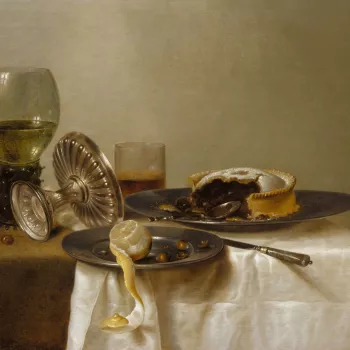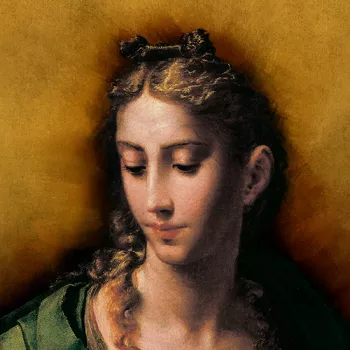The Grocer's Shop Signed and dated 1672
Oil on panel, arched at top | 41.5 x 32.0 cm (support, canvas/panel/stretcher external) | RCIN 405542
-
Dou was born at Leiden. He was a pupil of Rembrandt from 1628 until the latter moved to Amsterdam, probably in 1631. Dou rarely travelled outside Leiden, although he was invited to England by Charles II. He was a genre painter and founder of the school of the so-called fijnschilders (fine painters). His style was greatly admired and his work was much sought after in his own day. A number of pictures, for example, were sent to Sweden for the collection of Queen Christina. His reputation lasted into the eighteenth and nineteenth centuries.
The Grocer’s Shop by Dou is a late work, warmer in tone, richer in colour and more expansive in style than A girl chopping onions (Royal Collection), painted nearly thirty years earlier. Dou had first essayed this theme in 1647 (Paris, Louvre). Its origins lie in sixteenth-century market scenes undertaken by artists such as Joachim Beuckelaer and Pieter Aertsen, but Dou here combines several of his favourite motifs, particularly his desire to create a pictorial illusion. The scene is incorporated within a stone arched window with a ledge. Below is a sculpted relief of children playing with a goat, in the style of François Duquesnoy. The same relief occurs in The Poulterer’s Shop (National Gallery, London), which is close in date to the present painting. Although Dou uses an illusionistic device, he in fact distances the viewer from the scene by positioning objects in the foreground and on the ledge. There is, too, a strong sense of narrative, which is not limited to the two principal figures, but extends to the background where a woman (looking directly at the viewer) holding a coffee pot is about to leave the shop, whilst behind her another customer is being served. At this late stage of his life Dou does not differentiate his brushwork so that all the textures are treated evenly - including the impressionistically rendered curtain on the right.
The type of shop that Dou depicts is eminently respectable and indicates the great success that the Dutch nation had in trading. Market stalls and pedlars still existed, but shops put commercial transactions onto a more formal basis and Dou’s compositions have a distinctly domestic feel to them, as though a deliberate extension of the home. The Dutch economy can be seen here at work. He has depicted a general store that sells eggs, dairy products, bread and meat products. There are also exotic goods that show how open the Dutch economy was to imports. The lemons on the ledge are on a blue and white oriental ceramic dish; there are sponges hanging in the arch; and special confections are in a jar on the ledge. At the centre of the arch are poppies used for making syrup, but also associated with apothecary shops. There is in all of this a sense of changing fashion and an opening up to French influence detectable in the style of dress, as well as in the choice of comestibles.
Inscribed lower right: 'GDOV [GD in monogram] 1672'
Catalogue entry adapted from Enchanting the Eye: Dutch paintings of the Golden Age, London, 2004Provenance
Comte de Choiseul, Paris, by 1754; Choiseul-Praslin sale, Paris, 1793; bought Paillet; purchased in Paris by William Buchanan, 1817; Thomas Thompson Martin, from whom purchased by the Prince Regent, 21 June 1817; recorded in the Rose Satin Room at Carlton House in 1819 (no 27); in the Picture Gallery at Buckingham Palace in 1841 (no 63)
-
Medium and techniques
Oil on panel, arched at top
Measurements
41.5 x 32.0 cm (support, canvas/panel/stretcher external)
62.4 x 48.9 x 4.5 cm (frame, external)
Category
Object type(s)
Other number(s)
Alternative title(s)
The Grocer's Shop: a Woman Selling Grapes














